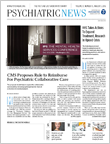It is well known that postpartum depression is a common disorder that can adversely affect the health of both the mother and child. What is less talked about, experts say, is how important identifying when a mother’s depression originates might be to guiding treatment decisions.
“The onset time of depression diagnosed in a postpartum woman has implications for the potential severity of the disease and how it should be treated,” Sheehan Fisher, Ph.D., an instructor of psychiatry and behavioral sciences at Northwestern University Feinberg School of Medicine, told Psychiatric News. However, the natural fluctuations in a woman’s hormones and mood during and after pregnancy can make it difficult to pinpoint just when symptoms of depression first emerge.
In an effort to identify characteristics that might distinguish the time of onset and type of depression identified during the postpartum period, Fisher and colleagues from Northwestern and the University of Pittsburgh assessed 727 mothers who had received a diagnosis of postpartum depression four to six weeks after giving birth.
The study participants were given a comprehensive clinical assessment to categorize all their symptoms and identify the depression onset date. The assessment revealed that 25 percent of the women developed depression before pregnancy, 37 percent during pregnancy, and 38 percent after the birth of their child; 75 percent of the women were diagnosed with unipolar depression and 25 percent had bipolar depression.
The women were screened using the Structured Clinical Interview for DSM-IV (SCID) for Axis I Disorders and the Structured Interview Guide for the Hamilton Depression Rating Scale-Atypical Depression Symptoms (SIGH-ADS), a comprehensive assessment that looks at 21 typical and eight atypical depressive symptoms. Of these 29 symptoms, four (difficulty falling asleep, hypersomnia, paranoia, and obsessive-compulsive traits) were substantially different between the groups.
Women who had depression before they became pregnant were more likely to have experienced paranoia, insomnia, or hypersomnia during the course of illness, whereas obsessive-compulsive symptoms were most pronounced in women who developed depression in the postpartum period and least pronounced in those with an onset during pregnancy.
Fisher said that these symptomatic differences are not surprising, as postpartum depression is often tied to concerns over the health and safety of the newborn child.
The authors also examined whether any symptoms could differentiate unipolar and bipolar depression, and found that agitation was significantly higher in women who received a bipolar diagnosis, regardless of onset time.
When looking at composite scores on clinical assessments, the differences between the groups were limited. While women with pre-pregnancy depression had a marginally significant increase in total SIGH-ADS score compared with the other two groups, there was almost no difference when factoring in the score for only the 21 typical symptoms.
The findings suggest that “clinicians cannot just look at total scores when trying to diagnose the onset of depression in a postpartum woman,” Fisher told Psychiatric News.
“The differentiation of chronic, semi-acute, and acute depression reveals the vulnerability and resiliency of the depression identified in the postpartum,” Fisher and colleagues wrote. “A comprehensive assessment of onset timing, typical and atypical symptoms, and unipolar versus bipolar disorder is recommended to improve the effectiveness of postpartum treatment.”
This study was published May 28 in the Journal of Affective Disorders and was supported by a grant from the National Institute of Mental Health. ■
An abstract of “Factors Associated With Onset Timing, Symptoms, and Severity of Depression Identified in the Postpartum Period” can be accessed
here.

